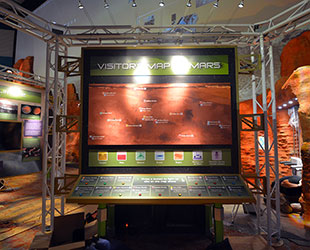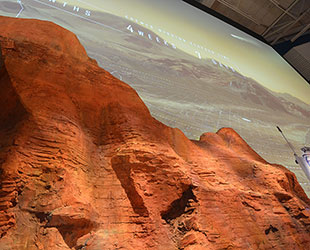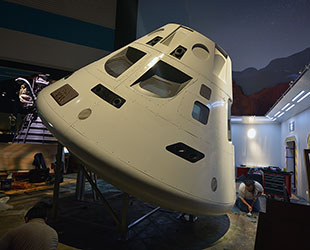January 19, 2017 — NASA's plans to send astronauts to Mars come alive in a new interactive exhibit opening to the public on Saturday (Jan. 21) at Space Center Houston.
From peering into an authentic Orion capsule to touching a real piece of the red planet, the new "Mission Mars" exhibit invites guests to step onto the Martian surface as they tour the official visitor center for NASA's Johnson Space Center in Texas.
"Visitors will experience what it takes to travel to Mars, the hardware that will take us to the fourth planet in our solar system, and how humans may live on the red planet in the next few decades," said William Harris, president and CEO of Space Center Houston, in a statement.

"Mission Mars" at Space Center Houston presents visitors with the past, present and future of Mars exploration. (collectSPACE) |
"[This] new major exhibit will inspire the next generation of explorers who could one day walk on Mars," stated Harris.
"Mission Mars," developed with NASA, features digital and physical displays that are designed to immerse the public in the future of space exploration. The exhibit, which spans the back of Space Center Houston's main plaza, engages visitors from the moment they enter the building, by way of a multi-story-tall, animated look at the horizon on Mars.
In the course of a four-minute-long, 4K-projection, visitors can watch as the sun rises over Mars, a spacecraft arrives with astronauts from Earth and a robotic rover explores the planet. The state-of-the-art backdrop, which also includes an orbiter high above the surface and a view of the planet after the sun has set, merges into the physical outcrop of a simulated Martian cliff that extends into the "Mission Mars" exhibit.

A multi-story-tall, 4K projection blends into the physical outcrop of a simulated Martian cliff in "Mission Mars." (collectSPACE) |
Between red, orange and brown rocky façades, guests are presented with a variety of hands-on displays, including an interactive map showing where past robotic explorers have landed and a small collection of genuine Martian rocks. Of the 60,000 known meteorites on Earth, fewer than 150 are from Mars; the exhibit includes three samples from the red planet and, for a limited time, a fourth Mars meteorite that the public can touch.
Other interactive stations enable visitors to experience the difference between gravity on Earth and Mars, to see how plants and fresh food are grown in space, and how to suit up an astronaut to go out onto the Martian surface.
"Mission Mars" also exhibits a full-size research model that was used by engineers to develop the Orion spacecraft, a capsule to send future astronauts beyond low Earth orbit to cis-lunar space and, as part of a larger vehicle, outward to Mars.

An Orion spacecraft research model used by engineers at Johnson Space Center is on display in "Mission Mars." (collectSPACE) |
Visitors can look into the engineering model and then sit in a mock Orion to get a sense of what it will be like to ride aboard the capsule.
In addition, "Mission Mars" includes a 45-foot-tall (14 m), 1:8th scale model of NASA's Space Launch System (SLS), the towering rocket NASA is planning to use to launch the Orion, and a 14-foot-tall (4 m) authentic RS-25 engine that is of the same type that will power the SLS at liftoff.
"Mission Mars" is the first of several exhibits set to debut during Space Center Houston's year-long celebration of its 25th anniversary. The science and space education center, Houston's only Smithsonian affiliate museum, first opened on Oct. 16, 1992.
